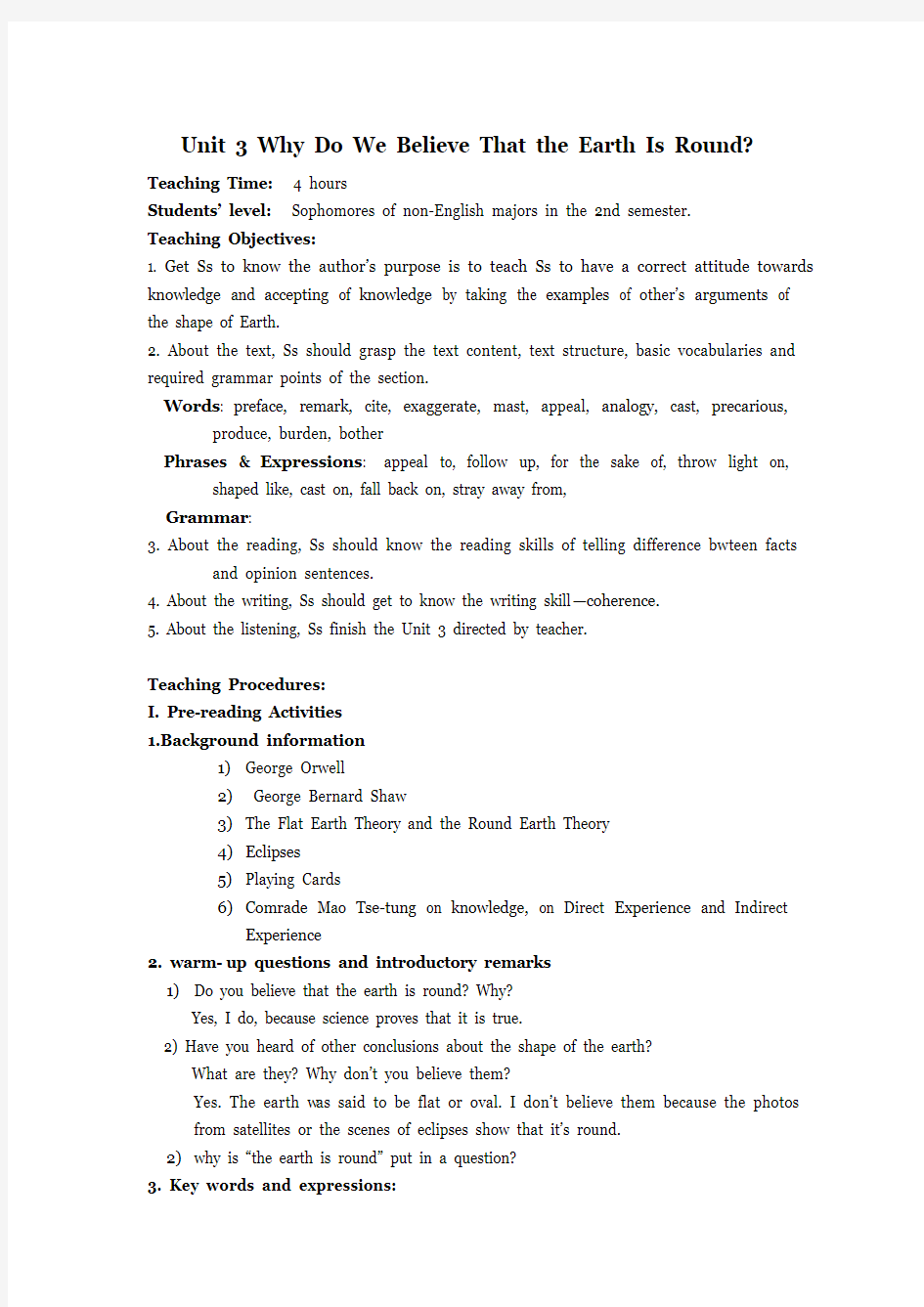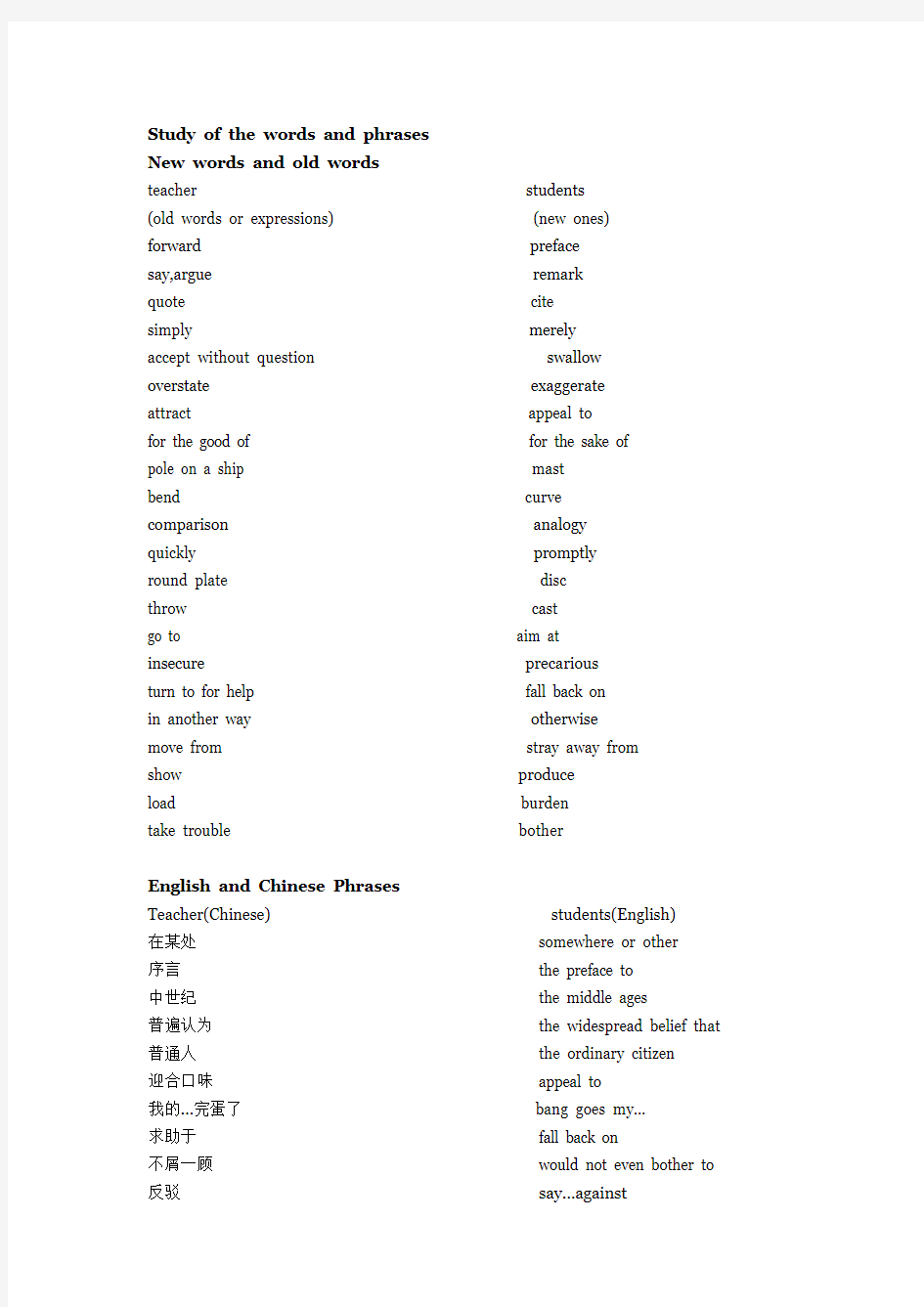

Unit 3 Why Do We Believe That the Earth Is Round? Teaching Time: 4 hours
Students’ level: Sophomores of non-English majors in the 2nd semester.
Teaching Objectives:
1. Get Ss to know the author’s purpose is to teach Ss to have a correct attitude towards knowledge and accepting of knowledge by taking the examples of other’s arguments of the shape of Earth.
2. About the text, Ss should grasp the text content, text structure, basic vocabularies and required grammar points of the section.
Words: preface, remark, cite, exaggerate, mast, appeal, analogy, cast, precarious, produce, burden, bother
Phrases & Expressions: appeal to, follow up, for the sake of, throw light on, shaped like, cast on, fall back on, stray away from,
Grammar:
3. About the reading, Ss should know the reading skills of telling difference bwteen facts
and opinion sentences.
4. About the writing, Ss should get to know the writing skill—coherence.
5. About the listening, Ss finish the Unit 3 directed by teacher.
Teaching Procedures:
I. Pre-reading Activities
1.Background information
1)George Orwell
2)George Bernard Shaw
3)The Flat Earth Theory and the Round Earth Theory
4)Eclipses
5)Playing Cards
6)Comrade Mao Tse-tung on knowledge, on Direct Experience and Indirect
Experience
2. warm-up questions and introductory remarks
1)Do you believe that the earth is round? Why?
Yes, I do, because science proves that it is true.
2) Have you heard of other conclusions about the shape of the earth?
What are they? Why don’t you believe them?
Yes. The earth w as said to be flat or oval. I don’t believe them because the photos from satellites or the scenes of eclipses show that it’s round.
2)why is “the earth is round” put in a question?
3. Key words and expressions:
Study of the words and phrases
New words and old words
teacher students
(old words or expressions) (new ones)
forward preface
say,argue remark
quote cite
simply merely
accept without question swallow
overstate exaggerate
attract appeal to
for the good of for the sake of
pole on a ship mast
bend curve
comparison analogy
quickly promptly
round plate disc
throw cast
go to aim at
insecure precarious
turn to for help fall back on
in another way otherwise
move from stray away from
show produce
load burden
take trouble bother
English and Chinese Phrases
Teacher(Chinese) students(English)
在某处somewhere or other
序言the preface to
中世纪the middle ages
普遍认为the widespread belief that 普通人the ordinary citizen
迎合口味appeal to
我的…完蛋了bang goes my…
求助于fall back on
不屑一顾would not even bother to 反驳say…against
天体heavenly body
由此可见it will be seen that
靠不住的理由precarious reasons
知识面the range of knowledge
无力的论据weak argument
II. While-reading Activities
1.Ss have the silent reading on the text (10 mins)
2.T explains the text in details.
Appeal to
1.do detective films appeal to you?
Yes, ….
No, … .
2.what kinds of books appeal most to youth?
Books on …
3.why are children’s clothes colorful?
Bright and colorful clothes usually appeal to children.
Follow up
1.what do the police do if a case is reported to them?
They follow up the case.
2.what do you do if you read an interesting story series on a newspaper?
I follow it up.
For the sake of
1.what do people usually do for the sake of health?
They eat healthy food, do exercises and don’t smoke,don’t…
2.why is it necessary to widen the streets?
It’s necessary to widen the streets for the sake of a smoother flow of traffic. Throw light on
1.what is the use of the background knowledge of a story?
It throws light on it.
2.why are illustrations, data and charts or tables necessary in scientific reports or
business presentations?
They throw light on the reports and presentations.
Shaped like
1.Why is a UFO also called a flying saucer?
It is shaped like a saucer.
2.what is a space shuttle like?
It is shaped like a huge plane.
Cast on
1.what can you see on a moon-lit night in the open?
I can see my shadow cast on the ground.
I can see the shadows of the trees cast on the wall/window.
Fall back on
1.why do you set aside some money every month?
I set aside some money every month so that I can fall back on it if I get sick or become
unemployed.
2.what do you do when you get lost in a new city?
I fell back on the police.
Stray away from
1.what must you bear in mind when you walk along a path in an area of swamp?
I must not stray away from the path.
2.what kind of people don’t you like to talk to?
I d on’t like to talk to those who often stray away from the topic.
Text and questions for discussion
Lines1-7
1.why is “ Saint Joan” in italics?
It is the name of a play. See note 3 in your textbook.
2.who is Bernard Shaw?
See Note 4 in your textbook. He is widely considered the treatest British dramatist since Shakespeare. He was awarded the Nobel Prize for literature in 1925. For more details, refer to Note 1,2. in Teacher’s book.
3.what do “gullible and superstitious” mean?
Gullible means willing to believe anyt hing or anyone, easily deceived. “superstitious”
means willing to believe something that cannot be explained by reason or science or that brings good or bad luck.
4.can you paraphrase “swallows this theory”?
accepting the theroy blindly without questioning and suspicions.
Lines 8-13
1.what does “it” refer to in the sentence “ the light it throws on modern knowledge”?
It refers to “ the question”
2.what is the question that is worth following up?
Are we too gullible and superstitious today?
3.why does the author only tend to speak of ordinary men when answering why we
believe that the earth is round?
Ordinary men don’t have the espertise to prove it scientifically.
Lines 14-19
1.why is a distant ship invisible but its mast and funnel can be seen from the seashore?
Look at the picture on the next page.
2.can you paraphrase “what can I say against it?”
I can refute the Flat Earth theory but I need more proofs to refute the Oval Earth
theory.
Lines 20-26
1.does the author really “play cards”?
no. this is a figure of speech u sed to mean preenting an argument point by point. “the first card I can play” means the first pointi can make to support my argument.
2.what does “analogy of the sun and moon” mean?
To compare the earth to the sun and the moon.
Lines 27-31
1.when does a lunar eclipse occur?
When the earth passes between the sun and the moon and blocks the sunlight, or casts its shadow onto the moon, a lunar eclipse occurs.
https://www.doczj.com/doc/f716047481.html,e the Oval Earth theory to refute the author’s eclipse argument.
The shadow cast on the moon is round, b ut it doesn’t follow that the earth is spherical.
It may perfectly well be flat like a disc.
3.what is the author’s argument about the eclipses based on?
Publications, such as newspapers and magazines.
Lines 32-39
1.what does the author mean by “ the minor exchanges?”
the less important points of debate.
2.what does the author think of his previous defeats?
He considers them minor/unimportant points, and he is hopeful to win in the debate.
3.who is Royal?
See note 6.
4.which is higher, Queen,King, or Ace?
King is higher than Queen,and Ace is higher than King.
5.can you paraphrase the last sentence?
Refer to note 23.
Lines 40-46
1.what does “bang goes my ace” mean?
My ace doesn’t work. I lose my ace. My argument isn’t conclusive.
2.what does the author think of his “ last card”?
he believes that the last point of his argument defeats the Oval Earth man.
Lines 47-60
1.what does the author think of his evidence?
He doesn’t think it convincing enough.
2.what does “an exceptionally elementary piece of information” mean?
A piece of information that everyone knows.
3.what is this piece of information?
The earth is round.
4.can you use a Chinese saying to explain “when the range of knowledge is so vas that
the expert himself is an ignoramus as soon as he strays away from his own specialty”?
隔行如隔山
5.what does “ credulous” mean?
Ready to believe, without evidence.
3.T asks Ss to come out the main idea, structure of the text (10mins)
Summary questions and Concluding remarks
1.what cards does the author play to refute opinions different from his?
The phenomenon of the seashore view, the analogy of the sun and the moon, the earth’s shadow, the newspapers and books, the opinions of the experts, and navigation.
2.do you have any other cards to support the author?
High above on a plane, we can see the curved horizon, still higher above in a space ship, astronauts tell us that the earth is round, like a ball. Pictures taken from spaceships or sky labs show the earth in no other shape than spherical.
3.can you sum up the main idea of this text?
III. Post-reading Activities
1.Let the students do the exercises in the textbook which are related to the new words.
2.Ss hand in the summary of the text.
3.Ss discuss the questions on the topic related to the text.
4.Let Ss do the exercises in the text book which are mainly related to the new words and topic.